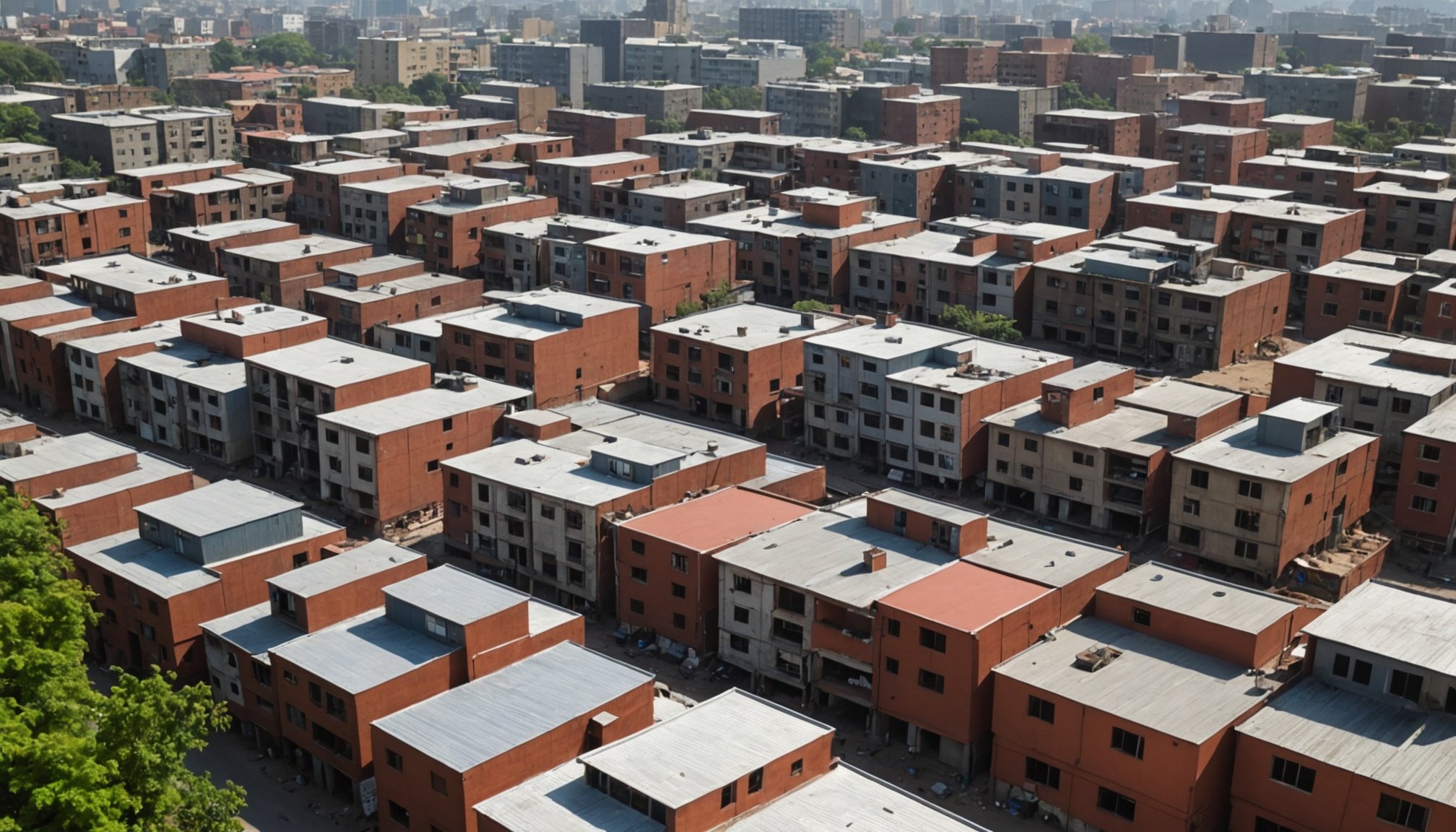Importance of Affordable Housing in Urban Areas
The housing crisis in urban areas is significantly impacting society. As cities grow, the demand for housing has outpaced supply, leading to skyrocketing prices. This shortage disproportionately affects lower-income households, intensifying societal inequality.
In densely populated settings, the scarcity of affordable housing has wide-reaching effects. Families may face housing insecurity, resulting in heightened stress and decreased quality of life. The lack of stable living conditions can disrupt children’s education and limit access to essential services. Moreover, the limited availability of affordable options contributes to the displacement of long-term residents, altering the social fabric of communities.
In the same genre : Discover the enduring benefits of opting for high-quality building materials in your projects
Investing in affordable housing solutions brings notable economic benefits. It stimulates local economies by creating construction and maintenance jobs. Furthermore, when individuals have access to stable, affordable homes, they can invest more in healthcare, education, and other local businesses, fostering economic growth. Employers also gain a more stable workforce as housing stability typically reduces employee turnover.
Governments and developers must prioritise affordable housing in urban development strategies to promote balanced and inclusive growth. By addressing these critical issues, cities can enhance their social and economic resilience, ensuring a thriving urban community for all residents.
Also to discover : Unleashing innovative tactics to reduce water use in uk households
Land Use and Planning Strategies
In managing land use planning within dense urban areas, efficient utilisation is essential to optimise space and promote affordable housing. Implementing mixed-use developments can address housing needs while providing commercial and recreational options. These developments integrate residential, retail, and office spaces, creating vibrant communities that reduce commuting needs and enhance quality of life.
Navigating zoning regulations is crucial for facilitating affordable housing. By adjusting these regulations, cities can allow higher densities, enabling the construction of more units on a given land area. This increase in urban density can help meet housing demands without expanding the city’s footprint unnecessarily. Furthermore, formulating zoning incentives can encourage developers to include affordable units in their projects.
Best practices include proactively engaging with stakeholders to ensure land use aligns with broader urban development goals. Collaboration with local communities and authorities can foster environments where affordable housing is prioritised within overall city planning. Key elements include strategic allocation of land resources and innovative zoning solutions that support diverse housing options. Through thoughtful planning and regulation adjustments, urban areas can better accommodate growth while maintaining affordability and accessibility for residents.
Financing Options for Affordable Housing Initiatives
Exploring financing options for affordable housing is crucial in addressing the housing crisis in urban areas. This includes leveraging various funding sources to ensure projects’ viability. Traditional loans, government grants, and tax incentives are frequently employed in affordable housing projects to lessen the upfront capital needed and the associated developer risks.
Public-private partnerships (PPPs) play a pivotal role in expanding affordable housing capabilities. By combining resources from both the public sector and private investors, PPPs can facilitate the development of housing projects that might not otherwise be feasible due to financial constraints. These partnerships often provide innovative solutions and shared expertise, enhancing project outcomes and fostering sustainable growth.
The role of government incentives is another significant aspect of financing affordable housing. Incentives may be in the form of subsidies, low-interest loans, or tax credits, making it more appealing for developers to undertake affordable housing initiatives. These government-driven benefits are instrumental in encouraging the development of housing options that cater to lower-income families, ultimately contributing to more balanced urban development. Investing in diverse financing strategies helps ensure the long-term success and sustainability of affordable housing efforts.
Innovative Design and Construction Techniques
Applying innovative housing design can significantly enhance the affordability and sustainability of urban housing. Sustainable and eco-friendly building materials, such as recycled steel or reclaimed wood, are critical for reducing environmental impact. These materials not only improve energy efficiency but also lower construction costs in the long run.
Adopting modular and prefabricated construction methods further bolsters construction efficiency. These methods enable quicker assembly times and reduce waste by producing components in controlled environments. Prefabrication minimises disruptions on-site and allows for precision in building, ultimately reducing costs and timelines associated with traditional construction.
The adaptive reuse of existing structures represents a compelling solution for sustainable building. By repurposing abandoned or underutilised buildings, cities can meet housing demands without the extensive resource use typically required for new constructions. This approach preserves historical architecture, contributes to urban renewal, and provides affordable housing solutions tailored to community needs.
Ultimately, integrating these construction efficiency techniques helps to develop housing that is not only affordable but also sustainable. Emphasising innovative design and sustainable practices better accommodates urban growth while significantly reducing the carbon footprint associated with new housing developments.
Community Involvement and Stakeholder Engagement
In the realm of urban development, community engagement plays a pivotal role in fostering successful and inclusive affordable housing projects. Including residents in the planning process ensures that housing developments are tailored to meet the real needs of those they aim to serve. An integrated, participatory approach not only reinforces trust but also enhances the project’s relevance and acceptance.
Stakeholder collaboration significantly contributes to the effective realisation of affordable housing initiatives. By involving various parties, including local governments, developers, and community organisations, projects can benefit from diverse perspectives and skills. This multifaceted involvement often results in creative solutions and shared ownership, which drive the project’s success.
Public participation can be encouraged through workshops, public consultations, and interactive forums. These platforms empower individuals to voice their concerns and suggestions, thus ensuring their active contributions to the development process. It’s crucial for developers to maintain transparent communication with all stakeholders to avoid conflicts and align goals.
An illustrative example of effective community involvement is the regeneration of a neglected urban neighbourhood into a vibrant community-focused housing project. This transformation was realised through persistent stakeholder collaboration, reflecting the benefits of inclusive planning in delivering sustainable and affordable living spaces.
Environmental Sustainability in Housing Development
Emphasising sustainable housing is crucial for minimising the environmental impact of urban development. By integrating green building practices, developers can significantly reduce energy consumption and promote long-term sustainability. Green infrastructure in housing projects often incorporates renewable energy sources, like solar panels, and efficient water management systems to conserve resources.
The benefits of energy-efficient designs include reduced utility costs for residents and decreased reliance on non-renewable energy sources. These designs can also enhance living conditions by ensuring better insulation and air quality, providing a healthier living environment.
Examples of successful environmentally sustainable housing developments illustrate the feasibility and advantages of this approach. Projects like the BedZED community in the UK showcase how combining sustainable architecture with community-focused planning can deliver both ecological and social benefits. The community utilises renewable energy, rainwater harvesting, and energy-efficient building materials to reduce its carbon footprint.
Ultimately, adopting environmental sustainability in housing development not only contributes to ecological conservation but also enhances housing affordability through reduced operational costs. This integrative approach ensures that future urban developments are resilient and sustainable, fostering healthier communities for generations to come.
Case Studies of Successful Affordable Housing Projects
Diving into compelling case studies provides valuable insights into the practical execution of affordable housing projects. These success stories illustrate innovative approaches that can deliver economic and social benefits. The integration of sustainable materials and community collaboration played pivotal roles in shaping these projects’ outcomes.
One standout example is the Quinta Monroy project in Chile. This project focused on incremental housing, allowing residents to expand their homes over time, suiting their economic capabilities. This innovative design not only reduced initial costs but also empowered residents by involving them in the building process.
In the Netherlands, the Borneo Sporenburg development transformed former docklands into a vibrant housing community. Famed for its inventive use of urban space, it combined mixed-use concepts to enhance livability and spur local economic growth.
Lessons from these projects underline the importance of stakeholder collaboration and adaptable planning. They highlight the need for clear communication strategies and flexible designs that cater to diverse community needs.
These key factors in successful implementations demonstrate how thoughtful planning and engagement lead to enduring positive impacts on both residents and the broader urban environment.











